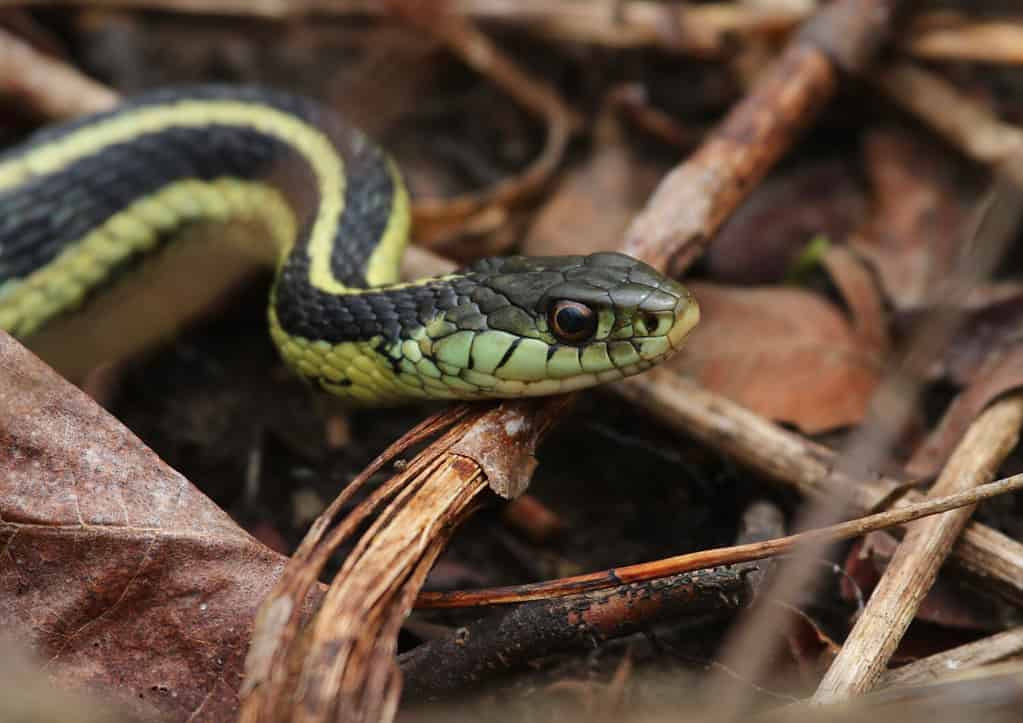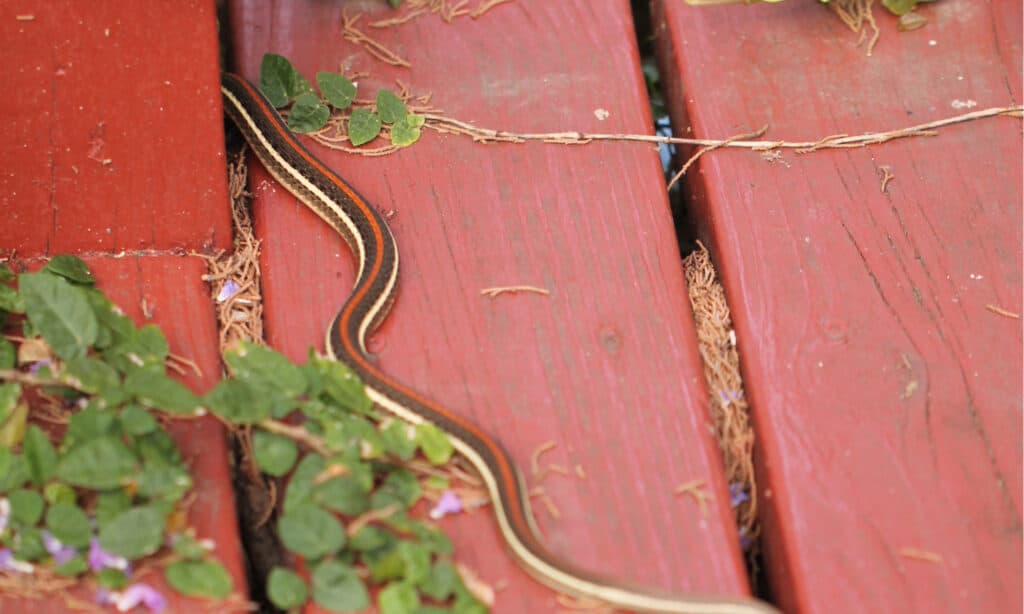About 150 species of snakes live in the United States. The majority of these are non-venomous and mostly harmless. They play a vital role in controlling the population of rodents and other pests. Garter snakes (genus Thamnophis) are common in the United States and are our frequent companions while gardening or working outside. Garter snakes vary considerably, so how do they compare to other snakes, and how big do they get?
A Few Facts About Garter Snakes
- Most snakes lay eggs, but the common garter snake will give birth to 10-40 live snakes, which are immediately independent.
- Garter snakes are flexible and can twist into more defensive positions than other snakes.
- When they mate, garter snakes form into groups, or “mating balls,” made of more than a dozen males and one or more females.
- Though some snakes seem frightening, garter snakes are essential to pest control for gardens and urban areas.
- Garter snakes are relatively harmless, though their bites contain some venom to help subdue their prey. This venom is not strong enough to harm humans.

The average garter snake is about the same size as the width of a yoga mat.
©Chris Hill/Shutterstock.com
Types of Garter Snake
Garter snakes are distributed widely throughout North America, with about 35 species listed in the chart below.
| Common Name | Scientific Name | Distribution |
|---|---|---|
| Aquatic garter snake | Thamnophis atratus | Arizona and New Mexico, and in the Mexican states of Sonora, Chihuahua, and Durango |
| Blackbelly garter snake | Thamnophis melanogaster | Mexico |
| Blackneck garter snake | Thamnophis cyrtopsis | Central California |
| Bogert’s garter snake | Thamnophis bogerti | Oaxaca, Mexico |
| Butler’s garter snake | Thamnophis butleri | Southwestern United States, Mexico, and Guatemala |
| Checkered garter snake | Thamnophis marcianus | Southwestern United States, Mexico, and Central America |
| Common garter snake | Thamnophis sirtalis | North America |
| Conant’s garter snake | Thamnophis conanti | Puebla and Veracruz, Mexico |
| Cope’s mountain meadow snake | Thamnophis copei | Mexico |
| Fox’s mountain meadow snake | Thamnophis foxi | Mexico |
| Giant garter snake | Thamnophis gigas | Arizona and New Mexico, and in the Mexican states of Sonora, Chihuahua, and Durango |
| Godman’s garter snake | Thamnophis godmani | Central California |
| Goldenhead garter snake | Thamnophis chrysocephalus | Mexico |
| Highland garter snake | Thamnophis fulvus | Mexico, Guatemala, Honduras and El Salvador |
| Liner’s garter snake | Thamnophis lineri | Mexico |
| Longtail alpine garter snake | Thamnophis scalaris | Mexico |
| Madrean narrow-headed garter snake | Thamnophis unilabialis | Mexico |
| Mexican garter snake | Thamnophis eques | Mexico and in the United States (Arizona and New Mexico) |
| Mexican wandering garter snake | Thamnophis errans | Chihuahua, Durango, Jalisco, Nayarit, and Zacatecas States of Mexico |
| Montane garter snake | Thamnophis exsul | Mexico |
| Narrow-headed garter snake | Thamnophis rufipunctatus | Central California to Baja California, Mexico |
| Northwestern garter snake | Thamnophis ordinoides | California, Oregon, and Washington; in Canada, it is found in British Columbia |
| Plains garter snake | Thamnophis radix | Southern Mexico |
| Ribbon snake | Thamnophis saurita | Eastern North America |
| Rossman’s garter snake | Thamnophis rossmani | Mexico |
| Short-tail alpine garter snake | Thamnophis scaliger | Mexico |
| Shorthead garter snake | Thamnophis brachystoma | Central United States as far north as Canada and as far south as Texas |
| Sierra garter snake | Thamnophis couchii | California and Oregon in the United States |
| Southern Durango spotted garter snake | Thamnophis nigronuchalis | Durango, Mexico |
| Sumichrast’s garter snake | Thamnophis sumichrasti | Mexico |
| Tamaulipan montane garter snake | Thamnophis mendax | Mexico |
| Tepalcatepec Valley garter snake | Thamnophis postremus | Mexico |
| Two-striped garter snake | Thamnophis hammondii | Central British Columbia, central Alberta, and southwestern Manitoba in Canada, Central United States |
| West Coast garter snake | Thamnophis validus | Mexico |
| Western ribbon snake | Thamnophis proximus | Central California to Baja California, Mexico |
| Western terrestrial garter snake | Thamnophis elegans | central British Columbia, central Alberta, and southwestern Manitoba in Canada, Central United States |
| Yellow-throated garter snake | Thamnophis pulchrilatus | Mexico |
Garter Snake Size: How Big Do They Get?
Snakes vary tremendously in size, from the green anaconda growing up to 30 feet in length to the Barbados threadsnake, measuring up to about 4.09 inches. Garter snakes run toward the smaller side, reaching 18 to 51 inches—somewhere between the length of a windshield wiper and one-and-a-half golf putters.

Growing as long as one-and-a-half golf putters, garter snakes are not the longest.
©Matt Jeppson/Shutterstock.com
Garter Snake Size: Largest Garter Snake Ever Recorded
Though they range from 18 to 51 inches, most garter snakes will be between 22 and 30 inches. Occasionally, though, a garter snake will exceed this size.
In 2006, Jonathan Wiens, a master’s student at the University of Manitoba, discovered a red-sided garter snake with a length of 52.8 inches—the largest garter snake on record. He found the female while monitoring a den of snakes near Manitoba. The snake was over 12 years old, much older than the usually expected 4 to 5 years.
Places You’re Most Likely to Encounter a Garter Snake
Where you are most likely to encounter a garter snake has a little bit to do with distribution and a bit to do with the environment you find yourself in.
Garter Snake Range
As the most widely distributed snake in North America, garter snakes are present in all of the contiguous United States. The map below shows how many species are in each state.

Garter Snake Habitations
Much of the diet of garter snakes depends on the presence of amphibians. This explains their need to be close to water. Many of the species in the western parts of North America are more aquatic than otherwise. They can adapt to many habitats as long as water is nearby. Garter snakes live in forests, fields, grasslands, woodlands, and suburban lawns. You can sometimes see them near ponds with tall, grassy weeds. These are the places you are most likely to encounter a garter snake.

Garter snakes are large enough to hunt pests and small enough to get away quickly from threats.
©Cathleen Wake Gorbatenko/Shutterstock.com
Conclusion
Garter snakes live throughout North America and provide excellent pest control. Their bites are relatively harmless to humans, and they try to flee rather than attack when threatened. Their size also contributes to their non-threatening appearance, with lengths ranging from 18 to 51 inches.
The photo featured at the top of this post is © Eric Dale/Shutterstock.com
Discover the "Monster" Snake 5X Bigger than an Anaconda
Every day A-Z Animals sends out some of the most incredible facts in the world from our free newsletter. Want to discover the 10 most beautiful snakes in the world, a "snake island" where you're never more than 3 feet from danger, or a "monster" snake 5X larger than an anaconda? Then sign up right now and you'll start receiving our daily newsletter absolutely free.
Thank you for reading! Have some feedback for us? Contact the AZ Animals editorial team.







